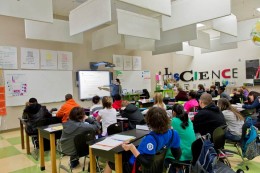Since attending the Dayton Regional STEM School, Bradley Hensley has learned Mandarin Chinese, built a coffee table out of cardboard based on a design by acclaimed architect Frank Lloyd Wright, and basically given his brain a full-impact workout.
Now, he and his fellow high school seniors are poised to apply their hard-won knowledge at the college level—Hensley at Wright State University and others at schools such as Texas A&M, Howard and the Rose-Hulman Institute of Technology.
The STEM school, which was born in 2009, will present its first graduating class of high school seniors on June 1. This is also the first year the school has operated at its full complement of grades 6-12, housing both middle and high school students and classes on one campus in Kettering. And it recently inducted the first group of junior and senior students into its new chapter of the National Honor Society.
“One of the things about the STEM school that interested me was that there were people coming from all over the community to try to build this school together,” Hensley said.
The school is one of 12 public STEM (Science, Technology, Engineering and Math) schools across Ohio. They are designed to offer students a relevant, real-world education that prepares them for college and the working world. The students participate in inquiry and project-based instruction that marries traditional STEM content with social studies, language arts, the fine arts, and wellness and fitness.
“Some really cool stuff goes on here,” said Laurie McFarlin, director of communications and partnerships.
A stroll through the school bears that out.
Common areas are rimmed by computer stations, which draw huddling knots of students. Open classrooms reveal in-progress lessons of everything from art to computer modeling. A fitness commons is used for walking, weightlifting, Zumba, fencing, Tae Bo and other activities.
Walls are dressed with posters of Mahatma Gandhi, Mt. Fuji with Japanese script, and an array of student artwork such as a collage of watercolor paintings of cells—an effort to fuse a lesson in art with biology. College pennants are pinned to the cafeteria wall, a tribute to the destinations of graduating seniors.
“This place is buzzing from 7:30 in the morning until 5 in the afternoon,” said McFarlin. “And the pep rally we had several weeks back for our robotics teams looked a lot like a sporting event.”
The school currently serves 430 students in grades 6 through12 who come from 28 different school districts in six counties. It fields seven robotics teams, middle school and high school Science Olympiad teams, a Destination Imagination team and a CyberPatriot team. Students have a chance to participate in Science Fair, Student Council, National Honor Society, Muse Machine, yearbook and community service.
The school doesn’t operate in a bubble, but instead strives to build relationships and connect with the outside world. One Principles of Engineering course is taught by employees from Air Force Research Laboratory. And student artwork finds itself on public display at places like Wright State and the Dayton Public Library.
Wright State is a founding partner of the school and the lead higher-education partner. The school’s staff is employed by the university.
“They have contributed people, time and hard dollars just getting this place off the ground and continuing to have it happen,” McFarlin said of Wright State. “I call them our guardian angels.”
The STEM school has become a living laboratory of sorts. Delegations of educators from as far away as Russia and East Asia have dropped in to check out the educational model.
Kevin Lydy, who teaches U.S. history and comparative religion at the STEM school, said the school accepts students of all different skill and ability levels. But hard work is the common denominator.
“We want students who are going to be motivated by academic challenges and give us their all,” Lydy said.
Philip Bottelier teaches introduction to engineering, conceptual physics, and computer modeling and simulation. Student netbooks are equipped with state-of-the-art software and they work in teams on re-engineering projects. The school also has a 3D printer on-site.
“It’s pretty high level,” Bottelier said. “They are remarkable kids.”
Hensley says the classwork is extremely challenging and there is encouragement for students to get their work done.
“It’s a very good thing,” he said. “I feel like I actually have to apply myself, have to do a lot of deep thinking. They teach you to be very independent.”
(Applications are being accepted for new students in grades 6 through 10 for Fall 2013. The application deadline is March 1, 2013, by 5 p.m. More information about enrollment is available via the School’s website: www.daytonstemschool.org)


 Wright State gold team captures 2024 Horizon League team title, Flynn individual champion
Wright State gold team captures 2024 Horizon League team title, Flynn individual champion  118 medical students to graduate from Wright State’s Boonshoft School of Medicine April 28
118 medical students to graduate from Wright State’s Boonshoft School of Medicine April 28  Wright State University continues to demonstrate its financial strength with another credit rating upgrade from Moody’s
Wright State University continues to demonstrate its financial strength with another credit rating upgrade from Moody’s  Thousands celebrate the end of Spring Semester with food, fun and friendship
Thousands celebrate the end of Spring Semester with food, fun and friendship  Nearly 1,500 students to graduate at Wright State’s spring commencement ceremonies
Nearly 1,500 students to graduate at Wright State’s spring commencement ceremonies 